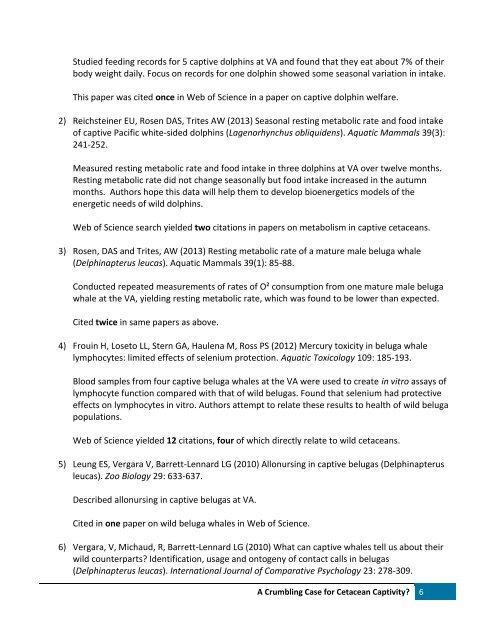A CRUMBLING CASE FOR CETACEAN CAPTIVITY?
MM-Education-and-Conservation-Report-Dec-9-2016-fi
MM-Education-and-Conservation-Report-Dec-9-2016-fi
Create successful ePaper yourself
Turn your PDF publications into a flip-book with our unique Google optimized e-Paper software.
Studied feeding records for 5 captive dolphins at VA and found that they eat about 7% of their<br />
body weight daily. Focus on records for one dolphin showed some seasonal variation in intake.<br />
This paper was cited once in Web of Science in a paper on captive dolphin welfare.<br />
2) Reichsteiner EU, Rosen DAS, Trites AW (2013) Seasonal resting metabolic rate and food intake<br />
of captive Pacific white-sided dolphins (Lagenorhynchus obliquidens). Aquatic Mammals 39(3):<br />
241-252.<br />
Measured resting metabolic rate and food intake in three dolphins at VA over twelve months.<br />
Resting metabolic rate did not change seasonally but food intake increased in the autumn<br />
months. Authors hope this data will help them to develop bioenergetics models of the<br />
energetic needs of wild dolphins.<br />
Web of Science search yielded two citations in papers on metabolism in captive cetaceans.<br />
3) Rosen, DAS and Trites, AW (2013) Resting metabolic rate of a mature male beluga whale<br />
(Delphinapterus leucas). Aquatic Mammals 39(1): 85-88.<br />
Conducted repeated measurements of rates of O² consumption from one mature male beluga<br />
whale at the VA, yielding resting metabolic rate, which was found to be lower than expected.<br />
Cited twice in same papers as above.<br />
4) Frouin H, Loseto LL, Stern GA, Haulena M, Ross PS (2012) Mercury toxicity in beluga whale<br />
lymphocytes: limited effects of selenium protection. Aquatic Toxicology 109: 185-193.<br />
Blood samples from four captive beluga whales at the VA were used to create in vitro assays of<br />
lymphocyte function compared with that of wild belugas. Found that selenium had protective<br />
effects on lymphocytes in vitro. Authors attempt to relate these results to health of wild beluga<br />
populations.<br />
Web of Science yielded 12 citations, four of which directly relate to wild cetaceans.<br />
5) Leung ES, Vergara V, Barrett-Lennard LG (2010) Allonursing in captive belugas (Delphinapterus<br />
leucas). Zoo Biology 29: 633-637.<br />
Described allonursing in captive belugas at VA.<br />
Cited in one paper on wild beluga whales in Web of Science.<br />
6) Vergara, V, Michaud, R, Barrett-Lennard LG (2010) What can captive whales tell us about their<br />
wild counterparts? Identification, usage and ontogeny of contact calls in belugas<br />
(Delphinapterus leucas). International Journal of Comparative Psychology 23: 278-309.<br />
A Crumbling Case for Cetacean Captivity? 6


